New California program is on a mission to reduce toxic chemicals in our everyday products
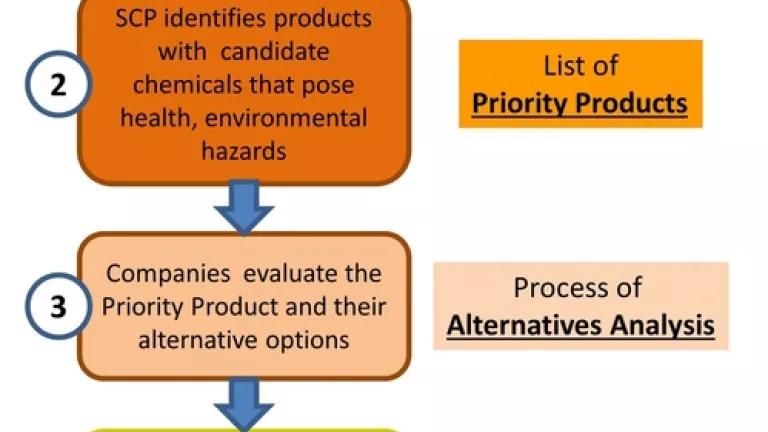
We've all probably heard about the problem of toxic chemicals in everything from baby sippy cups to kid's jewelry to pajamas to hair straighteners. While the problem of hazardous chemicals in our everyday products seems quite large, attempts to address this poisonous proliferation have usually been piecemeal. For example, the hormone disrupting chemical BPA has been banned from some products like sippy cups and baby bottles but not other drinking and food containers. BPA exposures can continue from these other products, and regrettably, it seems that the chemicals used to replace BPA may themselves pose health risks. So, while banning one toxic chemical from one product is a good thing, unfortunately it doesn't always protect us like we think it might. But the answer is not to resign ourselves to a parade of new unsafe chemicals. Instead, we need to fundamentally alter the way we assess and regulate chemicals, so that to toxic chemicals are eliminated and replaced with safer alternatives.
Back in 2008, California legislators and then-governor Arnold Schwarznegger wanted a more comprehensive solution like this-- one that would truly reduce toxic chemicals used in products while also drawing on the rich culture of cutting-edge innovation, technical and scientific expertise for which the Golden State is known. The result was the Green Chemistry Initiative, which led to the creation of the Safer Consumer Products (SCP) program, launched in 2013. The SCP program's mission is to reduce toxic chemicals in consumer products, while at the same time promoting safer technologies, safer chemicals, and green chemistry.
The basic idea of how the program works is shown in the diagram at left.
Step (1): chemicals that pose health and/ or environmental hazards are identified, called "Candidate Chemicals."
Step (2): SCP chooses consumer products containing candidate chemicals, called "Priority Products."
Step (3): Companies that make the Priority Product then have to evaluate their use of the hazardous chemical and search for something safer, using the process of alternatives analysis.
Steps (4)-(5): Finally, the SCP program issues regulations and products are changed to be safer for public health and the environment.
Above: The steps in the SCP process and terminology the program uses.
Maybe it seems pretty simple, but within each of these steps, the SCP program has some unique and exciting approaches seen in policies nowhere else in the country, giving the program a real chance for success. Let's take a closer look at what happens in each step.
Step 1: Candidate Chemicals
The list of Candidate Chemicals is drawn from authoritative sources such as the U.S. Environmental Protection Agency, the National Toxicology Program, and the Centers for Disease Control and Prevention.

SCP uses authoritative sources to identify a list of candidate chemicals that are hazardous to health or the environment.
Each one of the ~2000 or so candidate chemicals is hazardous to human health or the environment in some way-- it may cause cancer, disrupt hormones, persist in the environment, or have a number of other 'hazard traits' of concern that make it potentially harmful. The Candidate Chemical list is not static--it changes as the referenced authoritative lists change.
Hazardous chemicals that are not on the Candidate Chemical list can be added by petition to the SCP Program.
Step 2: Priority Products
But the Candidate Chemical list is just a long list of chemicals. The list doesn't tell you what products the chemicals are used in, so the next step is to connect candidate chemicals with a particular consumer product. Together, the chemical-product combination is called a Priority Product-- so far, the SCP program has proposed 3 "initial" Priority Products:
- Paint strippers with the chemical methylene chloride,
- Kid's padded sleeping items with chlorinated Tris flame retardant chemicals (like nap mats, sleep positioners, bassinet and crib pads)
- Spray polyurethane foam with the chemical methylene diphenyl diisocyanates (used as building insulation in walls, roofs, and attics)
Note that this is a different approach than is typically used by US EPA and other agencies--they usually focus on a single chemical and look at the use of that chemical in a variety of products. For example, US EPA recently looked at the chemical trichloroethylene in a variety of products used for degreasing, spot cleaning, and spray-on coatings. In contrast, the SCP listing focuses on a pretty specific set of products, and doesn't include other products that may contain the chemical. So, even though the initial Priority Products list includes two kinds of chlorinated Tris flame retardants, the listing is limited to kid's padded sleeping items, and wouldn't cover other products that might contain these flame retardants, like furniture. However, impacts from the candidate chemical CAN be considered more broadly, as described below.

SCP has chosen three initial Priority Products and will choose more products each year from their Work Plan.
Moving forward, the program will select additional Priority Products each year from categories of products listed on a Work Plan. There are seven categories of products listed on the work plan, including personal care products, cleaning products, and clothing.
How will the Priority Products be chosen?
There are lots of products out there that contain a chemical of concern--so how does the program decide which ones to name as Priority Products? SCP has two key criteria to consider when selecting Priority Products: (1) the potential for human and/ or environmental exposures and (2) the potential for exposures to cause adverse impacts, to humans and/ or the environment. Here, again there are some key, critical differences with SCP's considerations compared to other policy frameworks.
Escape from "paralysis by analysis": The criteria require the potential for exposure and adverse impacts--not demonstrated proof. Basically, this means that we don't need studies showing that children have been harmed by flame retardants in their nap mats--if there is the potential for them to be harmed, based on the evidence we have, then that is sufficient. SCP does not conduct "risk assessments"--these are the hundreds of pages long documents that attempt to quantify exactly how toxic a chemical is, and exactly how much of a chemical people are exposed to. The risk assessment framework can lead to what's called "paralysis by analysis"--getting stuck because we don't have comprehensive, complete data on every chemical, especially related to human exposure. SCP gets out of this conundrum by using the evidence we do have to make an informed decision.
Comprehensive consideration of adverse impacts: SCP can consider threats to human health AND the environment across the entire life cycle of a product. A product's life cycle begins when it is created (manufacturing), continues when it is used by consumers (use), and ends when the product is disposed by recycling, landfilling, or incineration. So, though we think about the safety of consumer products most often for the person who uses the product, in reality the consumer use phase is just one of the places where chemicals can have adverse impacts on people or the environment. Workers who make products are exposed to chemicals, and chemicals released during manufacturing can be toxic to the environment, for example by killing fish or polluting the air.
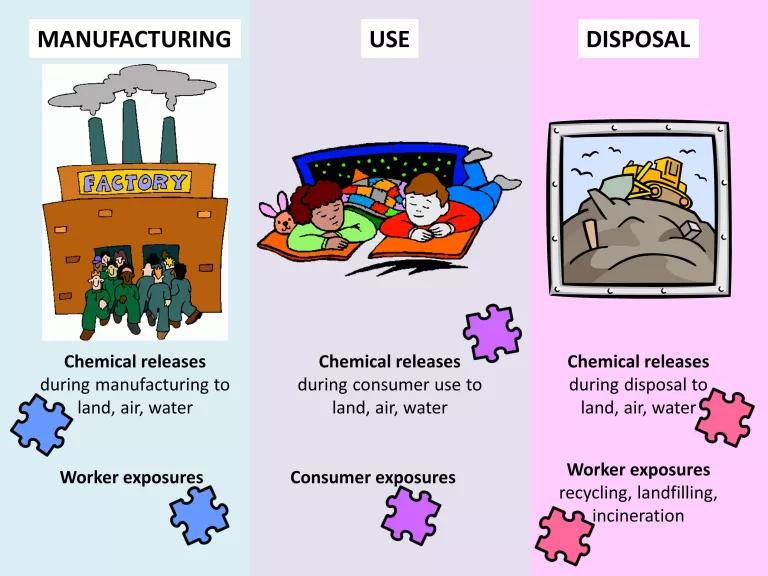
A chemical can cause adverse human health or environmental impacts throughout a product's life cycle, from manufacturing to use to disposal.
A major weakness of many other policy frameworks is that they only can look at a single "piece of the puzzle" in the picture above-- the focus is on either human health or environmental impacts, not both, and only in one phase of the life cycle. For example, a program that considers the safety of a chemical for workers in a factory focuses exclusively on the workers, and nothing else. The same chemical might harm aquatic life when released at low levels in the factory's wastewater, or present risks to consumers who use the product after it exits the factory. But because of the fragmentation and narrow scopes of existing frameworks, many of a chemical's adverse impacts go unaddressed.
SCP puts together the pieces of the puzzle because threats to human health and the environment are considered across the entire life cycle.
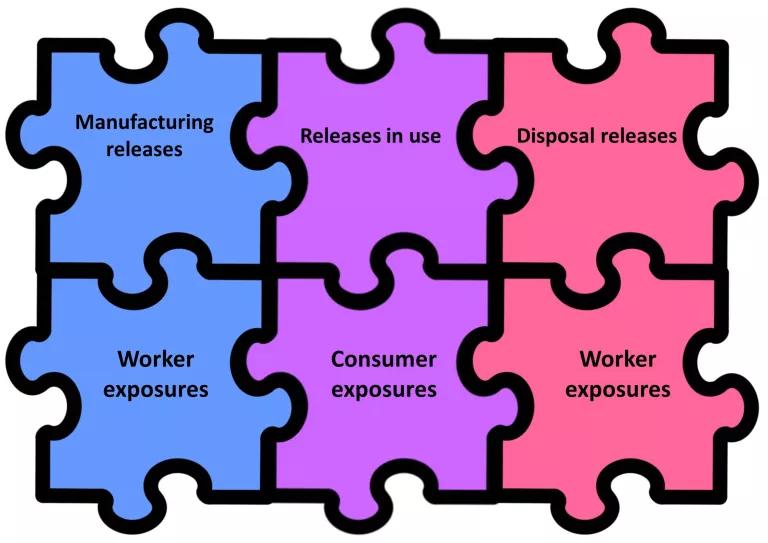
At left: SCP comprehensively considers potential adverse impacts to human health and the environment.
Additionally, SCP can evaluate the potential for adverse impacts in a real-world context--we're exposed to many chemicals at once, and the same chemical from different sources. So, even though a product listing might be quite narrow, as in the kid's sleeping products, the evaluation of the potential for adverse impacts can take into account exposure to the same flame retardants from other sources like furniture, and also the effects of exposure to multiple chemicals at once that might exacerbate the same negative health effect.
Step 3: Alternatives Analysis
Once a product with a toxic chemical is identified as a Priority Product, the next step is to figure out how to make a safer product. In another critical departure from other policy frameworks, this is the first question that SCP asks about the chemical: "Is it necessary?"
Note that this is very different from the question that is usually asked, which is: "Is it safe?" This question is problematic because it can lead directly again into paralysis by analysis, and trying to pinpoint precisely how toxic a chemical is, and precisely how much gets into people's bodies, and whether or not it's "safe."
But "is it necessary?" is typically a much easier question to answer--for example, are flame retardants necessary in children's nap mats? The answer is no--they are not needed to meet legal requirements, or for the function of the product. Flame retardant chemicals are usually there by accident, because scraps of foam left over from larger products are used to make smaller items like nap mats. For kid's sleeping products, the alternative is easy: use foam without flame retardants, thus removing the flame retardant chemical all together.
But what if a chemical is necessary in a product? Methylene chloride in paint strippers serves an essential function--it's the chemical that helps to actually remove paint. In this case, the next step would be to go through the process of alternatives analysis to determine if a safer substitute is available. In the process of alternatives analysis, possible substitutes are evaluated to determine if they are in fact safer for health and environment than the toxic methylene chloride. The risks of methylene chloride have been well known for decades--every year, people die from exposure to this dangerous chemical. Many safer substitutes are available, including less hazardous chemicals or using mechanical abrasion to remove paint.
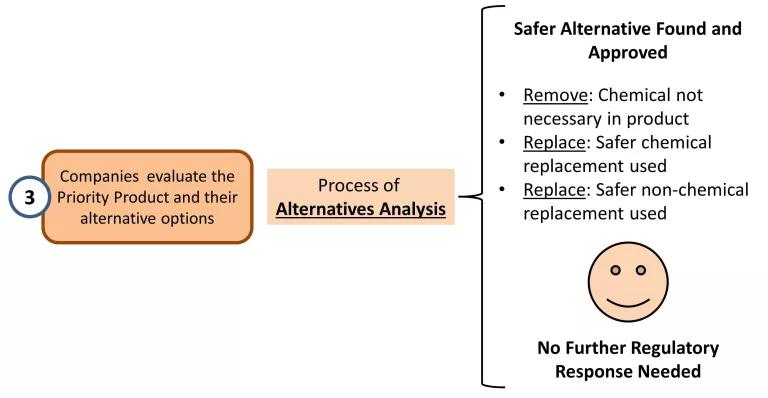
Sometimes a safer substitute may not be readily available--as seems to be the case for diisocyanates in spray polyurethane foam. The isocyanates serve as the backbone of the foam's structure. In this situation, green chemistry research is sorely needed, and the SCP program can help to spur and support innovation.
Step 4: Regulatory Response
If a safer alternative to a toxic chemical in a product is not found through the alternatives analysis process, SCP evaluates if a regulatory response is needed in order to protect public health and/ or the environment.
In choosing a regulatory response, SCP prioritizes "inherent protection" to avoid or reduce adverse impacts. This means trying to make a product or process fundamentally less hazardous, rather than attempting to control how much of a toxic substance people contact using administrative or engineering controls such as respirators. SCP may consider costs broadly, taking into account economic feasibility as well as the costs of adverse impacts.
There are a range of potential regulatory response options, including asking for additional information on the safety of a proposed alternative, limiting the amount of a toxic chemical used in a product, or requiring an end-of-life stewardship program (also known as extended producer responsibility) for the proper disposal of a product.
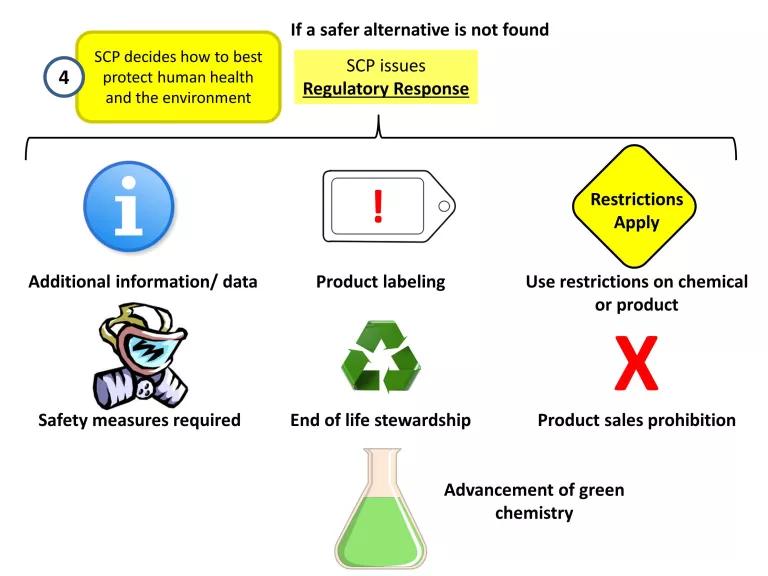
If a safer alternative is not found, SCP chooses a regulatory response that will best protect human health and the environment.
But unique amongst the regulatory response options is the "Advancement of Green Chemistry," where a product manufacturer is required to carry out a green chemistry research and development project or fund a challenge grant related to improving the design, performance, costs and/ or market penetration of safer alternatives. This is one way SCP can help lead to the creation, implementation, and wide adoption of new, cleaner chemicals, designs and technologies.
Step 5: Safer Products
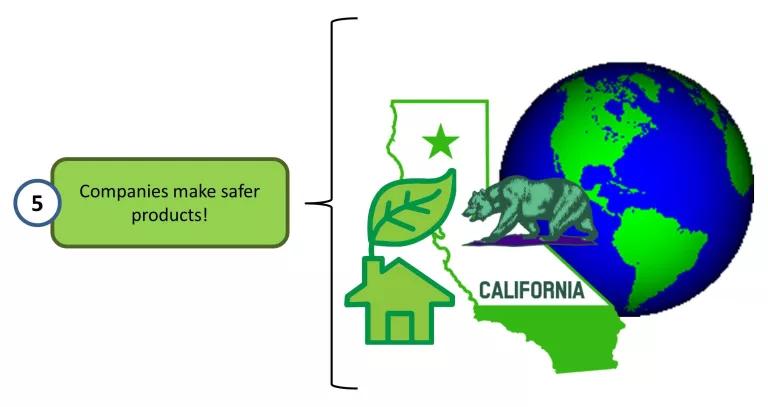
The vision is that through this iterative process, California and US businesses can become global leaders in a new safer products economy, while also benefitting public health and creating a cleaner environment.
